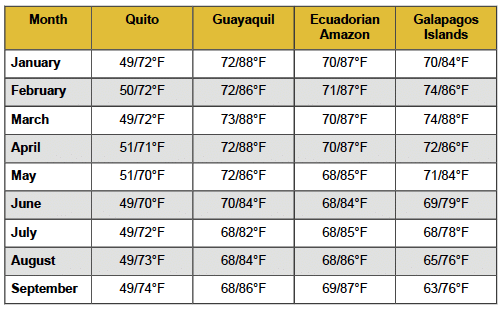ECUADOR

Fun Facts From Globus Tours
-
-
- Quito is said to have the most pleasant temperature in the world, nicknamed “Land of Eternal Spring”
- Ecuador gained independence from Spain in 1822 and from Gran Colombia in 1830; therefore Ecuador celebrates two independence days.
- Ecuador has 54 UNESCO World Heritage sites and 19% of its country side is protected.
- The official currency of Ecuador is the US dollar, which was adopted in 2000 after Ecuador suffered a financial crisis and defaulted on their external loans in 1999. The currency that was used before this was called the Ecuadorian Sucre
-
Although travel to Ecuador is becoming steadily more popular, it is still one of South America’s best-kept secrets. Split by the Andes and rows of active and snow-capped volcanoes, Ecuador seers with energy. This small but diverse country offers a snapshot of South America unlike all the others. Considering its haunting cloud forests on the outskirts of Quito, where mists hover and protect thousands of wildlife species, as well as its unspoiled and endless variety, Ecuador offers distinctively unique experiences to its travelers. While South America is teeming with wildlife and adventure, Ecuador is especially accessible. For a small territory, it consists of four different regions – the Islands, Pacific Coast, the enrapturing Andes Mountain range, and rainforests. Ecuador draws visitors for its varied landscapes and for its unique position as the gateway to the Galápagos Islands.
Quito
While retreating to the mysteries of Ecuador’s wild forests, you’ll also want to spend a little time in Quito, Ecuador’s capital city – the highest capital city in the world. It was also one of the first deemed UNESCO World Heritage Sites in 1978 and is recognized for its cultural heritage, ancient Inca influence, and architecture. With a bustling and modern city center surrounded by impending volcanoes and mountains, and the “Old Town” of Quito, it is a diverse and enlightening place to visit.
Ecuador’s Amazon
Once you’ve had a taste of Quito, step into an adventure in Ecuador’s Amazon. The tropical climate of the Amazon grips you as you descend into the jungle, where one hectare of forest contains as many frog species as all of North America, where you can see a monkey small enough to sit on your fingertip, spot a spider that eats birds, and the world’s largest snake – the anaconda. The Amazon is a place where you will experience some of the greatest variety of wildlife in South America. A night walk, a canoe trip into the flooded forest, a canopy view from the treetops, and piranha fishing – these are only a handful of ways to revel in this exotic place. A Naturalist at your lodge will be able to walk you through this “hot spot” of biodiversity satisfying your curiosity and revealing things you couldn’t have imagined in your dreams. This is a wildlife wonderland.
Baños
Baños may well be one of the most fascinating destinations in Ecuador. Here you’ll encounter natural richness like you’ve never seen it before. It’s positioned in the heart of the Ecuadorian Highlands, sitting amidst vast hills, completely surrounded by volcanoes, phenomenal weather, hot springs and waterfalls. It’s green like you’ve never seen it, quiet, powerful, and remote. Truly one of the most captivating destinations in Ecuador – between the colonial city with its gothic-style cathedral made from volcanic rock, art galleries, local markets, and pedestrian mall to the mountain hot springs and dozens of waterfalls, you’re surrounded by brilliance at every turn.
Cuenca
This magical and almost fairytale-like city is becoming an increasingly popular destination in Ecuador for its idyllic weather, colonial architecture, and relaxing way of life. Cuenca is surrounded by the Andes, laced with cobble-stone streets, and inspired by European influences. As capital of the Azuay province, it is the country’s third largest city and a haven for artists and writers as well as a variety of foreigners who have chosen this charming and seemingly perfect place to settle for life. Dating back to 1557, the city is home to the old cathedral, built the same year, reflecting the rich history of this great city.
Riobamba
Nature seekers and lovers of spanning scenic vistas will find refuge in this fantastic city, set in the Chimborazo province. Its clean air, quaint but lovely city streets, slow pace of life and welcoming people put travelers immediately at ease. You will truly experience the feeling that you’re standing above the world at just over 9,000 feet here. Adventurists will love the unspoiled terrain and those looking for relaxation and a break from frenetic city streets will find enjoyment in the unrivaled beauty of Riobamba. And just outside of Riobamba, you can experience the thrill of Devil’s Nose by train – an engineering marvel that scales the walls of the deep canyon terrain, as it takes you to the impressive Ingapirca Ruins.
Guayaquil
Guayaquil is the coastal gateway to the Galápagos Islands and is a vibrant, populous and modern city. Parked between the Andes Mountain range and the Pacific Ocean, this city gives visitors the opportunity to enjoy views unlike many in the world.
Galápagos Islands
As you head out to the Galápagos Islands, prepare yourself for some of the most unique wildlife viewing in the world – the islands are legendary and it’s best to see them by exploring the major archipelagos by yacht or overnight cruise ships. Sail through azure waters while you follow the inspiration of Darwin’s theories and the thousands of fascinating creatures special to each island. Bartolomé Island and Sulivan Bay on Santiago Island are both named after Bartholomew James Sulivan, a lifelong friend of Darwin’s and Lieutenant during his time of research aboard the MS Beagle. Santiago is home to the only equatorial wild penguin in the world. On the Island of North Seymour, you can catch sight of the blue-footed boobies moving about the landscape, picking up their turquoise flapping feet in a sort of comical dance. This island also hosts a large number of frigatebirds, magnificent and massive – dominators of the bird species in the Galápagos. Observing Darwin’s history and his studies is an interesting part of visiting the islands. On Santa Cruz, you can visit the Charles Darwin Research Station – the perfect opportunity to discover more about a number of tortoise species that have been protected here. The Island of San Cristóbal, where Charles Darwin first laid foot in the Galápagos, hosts red and blue-footed boobies, sea lions, marine iguanas, dolphins, and the Chatham lava lizard, endemic only to the Galápagos. Santa Fé Island is one of the best places to stop and get in the water for a little snorkeling, as the sea turtles are abundant and the waters, clear. Your time in the Galápagos will be an endless concert of fascinating wildlife, mingling with their surroundings, the challenges they face, delicate ecosystems, and natural wonders at every turn. The “blogosphere” will be bursting with stories of all the splendors you’ve seen cruising around this equatorial wonder of the world.
Packed in a relatively small part of South America, Ecuador is one of the most diverse and fascinating destinations in the world. Adventure, cuisine, culture, wildlife, biological hot spots, and fun sit in waiting on the Pacific Coast, hovering over the equator, dominated by the Andes, graced with deeply captivating forests to the north and east, and glistening waters to the west. Ecuador is a perfect taste of some of the best of South America.
VISAS, PASSPORTS, AND OTHER ENTRY REQUIREMENTS
A visa for your visit to Ecuador is not necessary for US citizens. If you hold a passport from another country, check with your local consulate about requirements for travel to Ecuador
All passengers traveling internationally are required to have a passport. Most countries require that the passport be valid for at least six (6) months beyond the conclusion of your trip, so please check the expiration date carefully. It is also recommended you have a minimum of three blank pages in your passport when traveling, as many countries require blank pages. Please carry proper identification (your passport) on you and do not leave it in your suitcase or hotel room. Most countries have laws that require you to carry your passport with you at all times.
There is US$100 Galápagos National Park Entrance Fee for all travelers visiting the Galápagos. This entrance fee is included in your vacation and will be provided by your Local Host. There is also a US$20 Transit Control Card which all tourists to the Galápagos Islands must purchase. This card will also be acquired for you by the Local Host and is included in your vacation.
COUNTRY CODES
The country code for Ecuador is 593. When calling to Ecuador from overseas, dial your international access code (011 from the US/Canada), followed by the country code, area code, and phone number. Phone numbers in Ecuador are 8 digits in length. Dialing from the US/Canada: 011 593# ### ####.
CURRENCY
The official currency of Ecuador is the US Dollar.
Credit cards are accepted in Ecuador, and you should have no problems using them in larger shops and restaurants, though you may be charged an additional fee for using them. Visa and MasterCard are the most accepted. Smaller shops may ask you to pay in cash or have a minimum amount required to use credit card. Be prepared to show your passport with all credit card transactions.
Traveler’s checks are extremely difficult to exchange in Ecuador. Their use is not recommended.
For the most current exchange rates, please go to our website at Globusjourneys.com/Currency.
Credit cards are accepted in Costa Rica, and you should have no problems using them in larger shops and restaurants. Visa and MasterCard are the most accepted. Smaller shops may ask you to pay in cash or have a minimum amount required to use a credit card. Traveler’s checks are extremely difficult to exchange in Costa Rica. Their use is not recommended.
Bank Hours:
- Mon. – Fri.: 9 am – 1 pm & 2:30 pm – 5 pm
- Sat.: 10 – Noon
- Sun.: Closed
BUDGETING AND SHOPPING
The following budget guidelines are just approximate values or starting values for meals and are per person. Actual prices will vary widely by restaurant and city within a country but below are some averages as provided by our experienced personnel.
-
-
-
- The approximate cost of a soft drink/mineral water/coffee is US $0.75.
- An average lunch consisting of a salad or sandwich and a soda or water starts at approximately US $6.
- Dinner at a mid-range restaurant with dessert and a non-alcoholic beverage starts at approximately US $20.
-
-
Shopping
In open street markets, try not to touch items unless you are interested in purchasing them. If you would like to take photos, please ask permission. Most vendors are happy to have their picture taken with the item you have just purchased. If you are being confronted by vendors, smile, say nothing and then shake your hand low to say no. This is polite and they understand. For many people, saying “No” means I want it at a lower price and they will follow you in attempt to bargain.
In many areas of South America, bargaining for purchases is normal. First, ask for a price. Offer an amount slightly below what you wish to pay. It is important to be polite and smile while bargaining. In most cases, bargaining will not save you a lot of money. Keep different value bills folded and separated in different pockets, that way you can pull out the exact money you need, and sometimes this can close the deal. Opening a wallet or purse to pull a roll of bills out can lead to negotiation problems. Always finish the transaction with Thank You and a smile.
TIPPING
Bars and restaurants often add a service charge to the bill as a tip (generally 10%). It is customary to add additional 10-15% tip in cash to be handed directly to the service personnel.
-
-
-
- For a taxi, a tip of 10% is recommended.
- Tip hotel staff $1 for room or bar service.
-
-
ELECTRICITY AND ELECTRICAL OUTLETS
Outlets
Voltage for outlets is 110-220V. North American voltage is generally 110V. Therefore, you will need a converter for your travels. Adapters will be necessary to adapt your plug into the outlet, but these may not convert the voltage, so both devices are necessary. Ecuador uses common US outlets as well as European outlets – a round, 2-prong plug that looks like:

TEMPERATURES
Ecuador’s climate is generally very tropical and may be cooler in higher elevations. To help you plan, below are average low and high temperatures for Ecuador.


To convert to Celsius, subtract 30, then divide by 2. While not exact, this simple formula will give a close estimation.
FOOD SPECIALTIES
Potatoes will accompany almost every meal; rice is also a very popular side dish. Soup is a big part of lunch and dinner. Ceviche, empanadas, and locro de papa (a famous Ecuadorian soup with avocados, potatoes, and cheese) are other popular dishes. In restaurants, always ask if they have menus in English, as many establishments will.
Drinking Water
Bottled water is how many people drink water even at home. Never ask for tap water for many reasons. Ice is rarely used as well.
CUSTOMS AND CULTURE
Greeting and Interaction
-
-
- The best way to address people when you do not know their name is to simply use “Señor” (male) or “Señora” (female).
- It’s normal to introduce yourself with a polite greeting of “buenos días/tardes” (good morning/ afternoon or evening).
- Greeting customs in South America also incorporate a lot of personal contact. Women will generally greet other women by kissing once on each cheek, right to left. Men will also kiss women on the cheeks when greeting them, but handshaking is reserved for between two men.
- People here have a tendency to stand relatively close to each other when they are talking. Although you might find that this is perhaps a little too close for your liking, you should just accept that this is normal behavior, and trying to create more space between you and your counterpart could be seen as rude.
-
Public Restrooms
Ladies should always travel with tissue. If public restrooms have toilet paper, it is sometimes rationed. Hand sanitizers are recommended to bring with you as some bathrooms may not have hot water and soap. In some public restrooms you are required to pay a small fee.
FEW WORDS OF THE LOCAL LANGUAGE
Spanish: CONVERSATION

¡Hola! Hi!, ¡Buenos Dias! Good morning!, ¡Buenas Noches! Good evening!, Me llamo _______. My name is _______., ¿Cómo se llama usted? What is your name?, Mucho gusto. Pleased to meet you., ¿Cómo está usted? How are you?, Bien, gracias. ¿Y usted? Fine, thanks. And you?, Mas o menos So-so, ¡Hasta luego! See you later!, Adiós. Good-bye., Por favor. Please., Vivo en ________I live in _____________, (Muchas) gracias. (Muy amable.) (Many) thanks. (Very kind.), De nada. You’re welcome., Lo siento. I’m sorry., ¿Me permite? May I?, Disculpe. Excuse me. (To get someone’s attention.), Con permiso. Excuse me. (For leaving or passing through.), Perdón. Excuse me. (For sneezing, arriving late, etc.), ¡Salud! Gesundheit! (When someone sneezes.) Cheers! (For toasting with drinks.), ¿Me pasa _______ por favor? Could you please pass me _______?, Sí. Yes., No. No., Gracias Thank you, No entiendoI don’t understand, No hablo español I don’t speak Spanish,¿Habla inglés? Do you speak English?, ¿Dónde está el baño? Where is the bathroom?, Está cerca? Is it near?, Está lejos? Is it far?, Siga recto. Go straight ahead., Gire a la derecha. Turn right., Gire a la izquierda. Turn left., Nescito esto. I would like this., Una mesa para dos, por favor. A table for two, please., La carta, por favor. The menu, please., La lista de vinos, por favor. The wine list, please., primer plato appetizers, plato principal main course, postre dessert, Quisiera algo para beber. I would like something to drink., Un vaso de agua, por favor. A glass of water, please., Una Cerveza. Beer, Una Copa de vino tinto/blanco Glass of red/white wine, La cuenta, por favor. The check, please., Incluye la propina? Is the tip included?, Desayuno Breakfast., Comida lunch, Cena dinner, ¡Buen provecho! Enjoy the meal!, ¡Salud! To your health!, Está riquísima! It’s delicious!, Plato. plate, Tenedor. fork, Cuchillo. knife, Cuchara. spoon, Servilleta. napkin, Hielo. ice, Sal. salt, Pimiento. pepper, Azúcar. sugar, Sopa. soup, Ensalada. salad, Pan. bread, Mantequilla. butter, Pollo. Chicken, Carne. Beef, Cerdo. Pork, Quisiera la carne poco cocida. I like my steak rare., Quisiera la carne a medio cocer. I like my steak medium., Quisiera la carne bien cocida. I like my steak well done.
NUMBERS
Cero. Zero, Uno. 1, Dos. 2, Tres. 3, Cuatro. 4, Cinco. 5, Seis. 6, Siete. 7, Ocho. 8, Nueve. 9, Diez. 10, Once. 11, Doce. 12, Trece 13, Catorce 14, Quince 15, Dieciseis 16, Diecisiete. 17, Dieciocho. 18, Diecinueve. 19, Veinte. 20, Cien. 100, Mil. 1000.
U.S. DEPARTMENT OF STATE COUNTRY INFORMATION
Additional country-specific information for US citizens can be found on the US Government’s website www.travel.state.gov. Here, you can find the most up-to-date information about destination descriptions, passports/visas, safety and security, transportation, travel local laws, alerts/warnings, vaccinations, and more. For citizens of other nations, we recommend you consult your local consulate for travel information, regulations, and requirements.














